Quadrature Sampling Detector Introduction
General
The Quadrature Sampling Detector stage ("QSD" - Quadrature Sampling Detector) acts like two traditional direct conversion mixers operating in tandem. Each takes in half of the filtered and down-converted RF from the RF/Control and one of the quadrature center frequency signals, then "mixes"/down-converts them to with an output being the traditional mixer products, in this case, two (infra) audio frequency signals that represent the difference between the two inputs (down-convertedRF and Local Oscillator). These two signals are referred to as the detected I (in-phase) and Q (Quadrature) signals and are fed into the high gain Op-Amps stage for amplification and delivery to the audio outputs (and, thence, to the PC's sound card). The QSD is enabled by the QSD enable line, switched in the RF I/O Control Stage's U4 (or, as in these instructions, statically set via the "/QSD EN" shunt to ground).
Following on in the example from the RF/Control Stage, where the desired center frequency on the SDR program's display is 145.200 and the incoming RF signal to be detected is 145.210:
- The RF into the QSD is 29.05 MHz
- The Quadrature Clock signals are 116.16/4 = 29.04MHz
- The I and Q outputs are (Δ) 29.05 - 29.04 = 10 kHz
Quadrature Sampling Detector Schematic
(Resistor testpoints (hairpin, top, or left-hand lead), as physically installed on the board, are marked in the schematic with red dots)
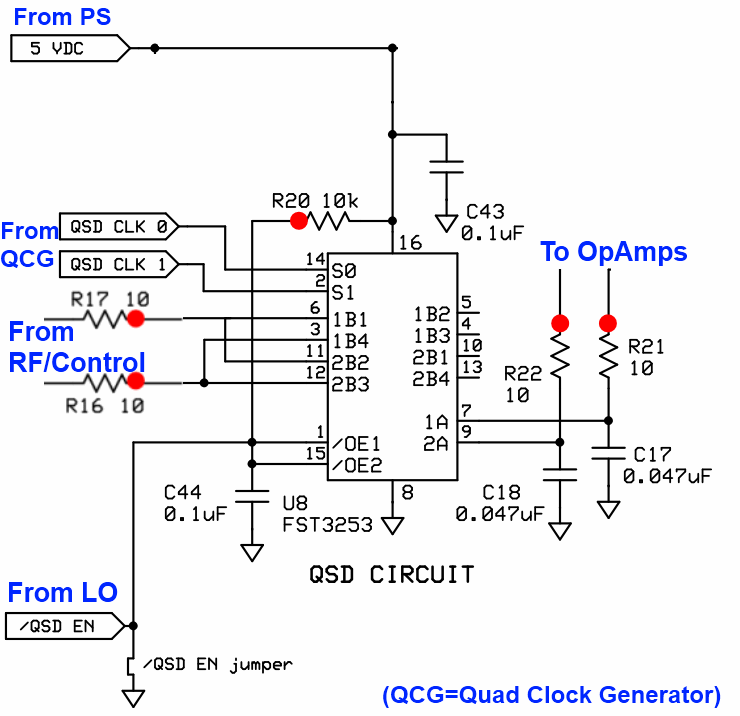
(above schematic has clickable areas that can be used for navigation)
(go directly to build notes)Quadrature Sampling Detector Bill of Materials
Stage Bill of Materials
(resistor images and color codes courtesy of WIlfried, DL5SWB's R-Color Code program)
| Check | Designation | Component | Marking | Category | Orientation | Notes | Circuit |
|---|---|---|---|---|---|---|---|
| ❏ | R16 | 10 ohm 1/4W 1% | br-blk-blk-gld-br
 | 1/4W | Quadrature Sampling Detector | ||
| ❏ | R17 | 10 ohm 1/4W 1% | br-blk-blk-gld-br
 | 1/4W | Quadrature Sampling Detector | ||
| ❏ | R20 | 10 k 1/6W 5% | brn-blk-ora-gld
 | 1/6W | Quadrature Sampling Detector | ||
| ❏ | R21 | 10 ohm 1/4W 1% | br-blk-blk-gld-br
 | 1/4W | Quadrature Sampling Detector | ||
| ❏ | R22 | 10 ohm 1/4W 1% | br-blk-blk-gld-br
 | 1/4W | Quadrature Sampling Detector | ||
| ❏ | C17 | 0.047 uF 5% | 473
 | Ceramic | Quadrature Sampling Detector | ||
| ❏ | C18 | 0.047 uF 5% | 473
 | Ceramic | Quadrature Sampling Detector | ||
| ❏ | U08 | FST3253 mux/demux switch | FST3253
 | SOIC-16 | Quadrature Sampling Detector | ||
| ❏ | C43 | 0.1 uF | (smt) black stripe
 | SMT 1206 | Quadrature Sampling Detector | ||
| ❏ | C44 | 0.1 uF | (smt) black stripe
 | SMT 1206 | Quadrature Sampling Detector |
Quadrature Sampling Detector Summary Build Notes
- Install SMT Cpmponents
- Install Topside Components
- Test the Stage
Quadrature Sampling Detector Detailed Build Notes
Bottom of the Board
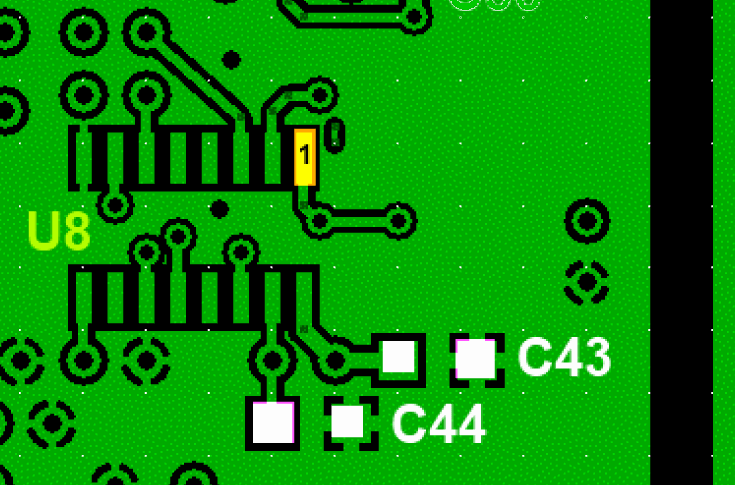
Install SMT Cpmponents
| Check | Designation | Component | Marking | Category | Orientation | Notes |
|---|---|---|---|---|---|---|
| ❏ | U08 | FST3253 mux/demux switch | FST3253
 | SOIC-16 | Take ESD precautions | |
| ❏ | C43 | 0.1 uF | (smt) black stripe
 | SMT 1206 | ||
| ❏ | C44 | 0.1 uF | (smt) black stripe
 | SMT 1206 |
Top of the Board
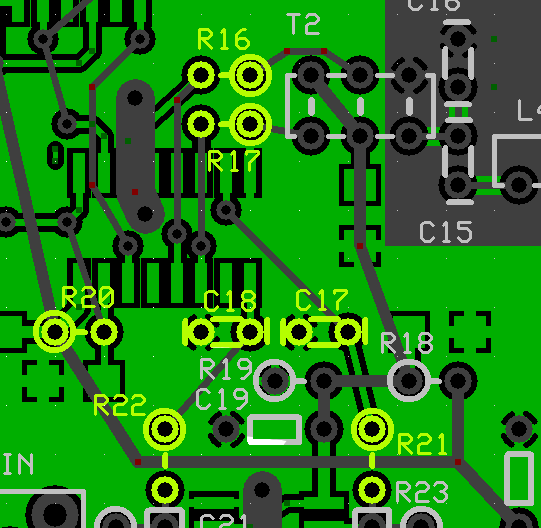
Install Topside Components
| Check | Designation | Component | Marking | Category | Orientation | Notes |
|---|---|---|---|---|---|---|
| ❏ | R16 | 10 ohm 1/4W 1% | br-blk-blk-gld-br
 | 1/4W | ||
| ❏ | R17 | 10 ohm 1/4W 1% | br-blk-blk-gld-br
 | 1/4W | ||
| ❏ | R20 | 10 k 1/6W 5% | brn-blk-ora-gld
 | 1/6W | ||
| ❏ | R21 | 10 ohm 1/4W 1% | br-blk-blk-gld-br
 | 1/4W | ||
| ❏ | R22 | 10 ohm 1/4W 1% | br-blk-blk-gld-br
 | 1/4W | ||
| ❏ | C17 | 0.047 uF 5% | 473
 | Ceramic | ||
| ❏ | C18 | 0.047 uF 5% | 473
 | Ceramic |
Quadrature Sampling Detector Completed Stage
Top of the Board
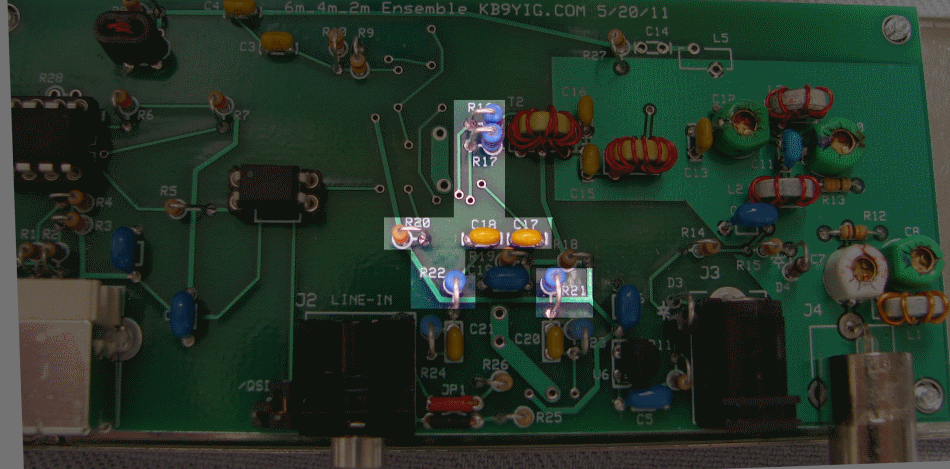
Bottom of the Board
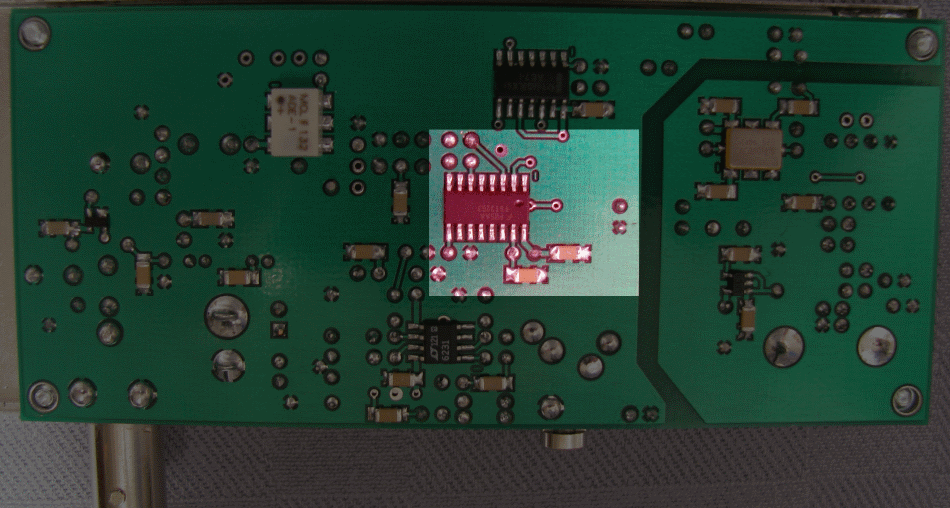
Quadrature Sampling Detector Testing
Pin Voltages
Test Setup
It has been observed before that some digital meters are affected by the square wave signals on IC pins and do not always read correctly. The readings you get should approximate 2.5V . The best instrument may be a good oscilloscope. Just be prepared to see slightly different readings on pins 10-13 and 3-6, depending on your DMM (mine is not the best!)
Just for a little background information, most of the voltages on U8 pins are derived from the potential divider formed by R18/R19 (installed and tested in the preceding RF/Control Stage). If in doubt you can always measure the junction of those two and should get 2.5v as they are equal values across the 5v rail. If one or both were the wrong value, that point would be significantly different. The 2.5v is passed through T2 to the input pins of the multiplexer, and appear on the output pins when the appropriate switch is enabled. Other pins have clock waveforms present, which are relying on the averaging effects of the measuring instrument to give an approximate reading of 2.5v, but this can vary tremendously.
Bob G8VOI provided the above note concerning these voltages.
Conduct the Test
Power the board, connect USB to PC
Voltages are measured WRT (regular) ground (/QSD EN shunt )
Measure pin voltages
It is best to test for these voltages at the actual pins (not the pads), thereby ensuring correct soldering of the pins to the pads.
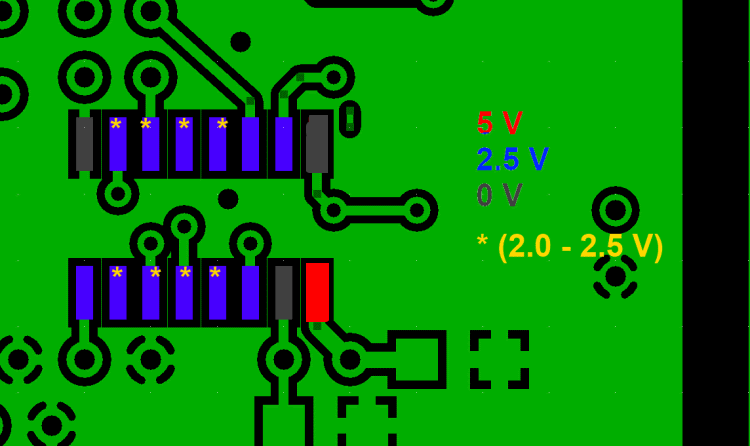
Test Measurements
| Testpoint | Units | Nominal Value | Author's | Yours |
|---|---|---|---|---|
| Pins 1 and 15 (gnd) | Vdc | 0 | _______ | |
| Pins 10, 11, 12, and 13 (40-50% of 5V rail - see note) | Vdc | 2.5 | _______ | |
| Pins 3, 4, 5, and 6 (40-50% of 5V rail see note) | Vdc | 2.5 | _______ | |
| Pins 7 and 9 (1/2 of 5V rail) | Vdc | 2.5 | _______ | |
| Pins 2 and 14 (1/2 of 5V rail) | Vdc | 2.5 | _______ | |
| Pin 8 (gnd | Vdc | 0 | _______ | |
| Pin 16 (5 V rail) | Vdc | 5 | _______ |